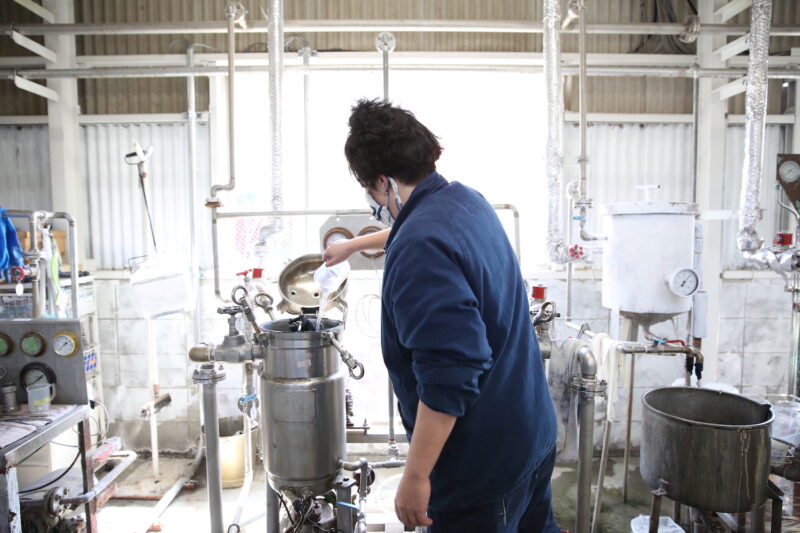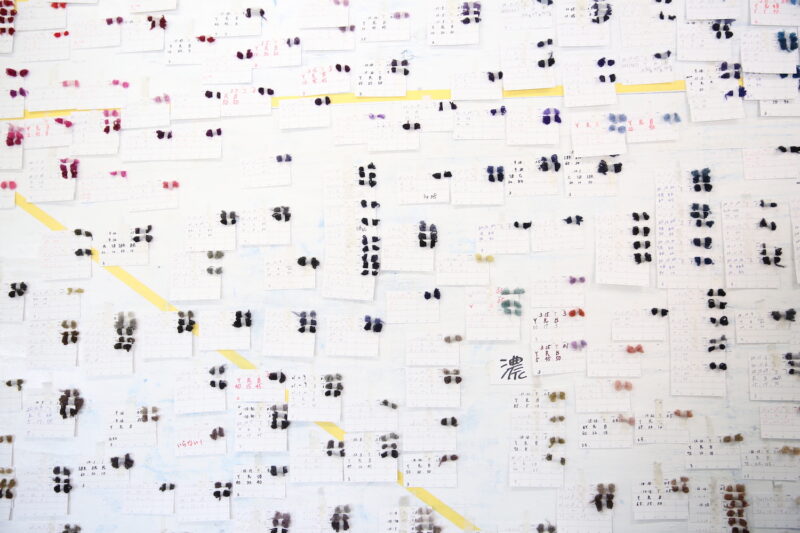niime 百科
Encyclopedia of niime
染めチーム・岩本に訊く、この1年。
The interview with Ms Iwamoto, a member of the 'Dye team' about this year.

2021 . 04 . 20
昨年2月、「染めチーム」を取材してより1年と少し。
その間、急速に拡大した新型コロナの影響により世の中と私たちの暮らしは一変した。緊急事態宣言を受け、コロナ禍にいち早く柔軟に対応したtamaki niimeにも大きな変化があった。タマスクの開発、Online Shopの構築と展開、直営店の改装オープン…。
例年にも増して密度の濃いスピーディーな1年間を経て「染めチーム」もどう変わったのか、スタッフの岩本典子に想いを訊いてみた。
岩本「去年の今頃は「染め」を止めて、マスクを縫ってましたね。バリバリ縫えるわけじゃないから、縫製のスタッフに教えてもらって一番簡単な部分を担当して。その後「タマスク」縫製のパートさんも増えてきて、1ヶ月くらいで現場に戻りました。しばらくの間は午前中だけ「染め」の仕事を回して、午後からは縫製に行ったり。」
tamaki niimeのモノづくりにとっても、「タマスク」製作にブランドの命運を賭けた「緊急事態」の日々。スタッフ総出でマスクづくりに注力していた。
コロナ禍をきっかけに広がった、「タマスク」という新たなモノづくりのフロンティア。「染めチーム」としてもマスクのヴァリエーション製作の試行錯誤の過程で新たな染め手法へのトライが実行された。
岩本「「染めあそび※」のひとつとして、マスクは口もとに付けるモノだからこそ、植物染料で染める提案をするのはどうだろう?とチームで話して。」
※「染めあそび」 伝統的な絞りや板締めなど様々な「染め」の技法を組み合わせ、「染めチーム」のスタッフが柔軟な発想で一点ずつ手染めする作品。
「botamask!」の誕生。植物染料によるボタニカル(=植物の)なマスクは、藍、茜、えんじゅ、ロッグウッドという植物を原料に染められ、リバーシブルに柄と付け心地を愉しめるアイテムになっている。
岩本「藍染した糸を織ってもらったり。基本的には先に糸を染めてそれが生地に使われるわけですけど、生成りの生地を織ってもらって、それを後染めしてタイダイ染めっぽい滲みのある模様を生み出したり。マスクのひもも、染めたのを編んでもらってひもにしてるんですよ。」
― 愉しいですね。
岩本「なので、「染めあそび」の、植物染料を使った後染めの作品発表は「botamask!」からなんですよ。価格的には上がるんですが、ニーズがあるから継続してその後ほかのアイテムにも展開していって、先染めと後染め両方あるという。」
コロナ禍によってマスクの需要が高まる中での「botamask!」の創造により、一気に「染め」のモノづくりの可能性が開けた。苦境をバネにする、tamaki niimeならではの前向きなチャレンジがここでも大きく実を結んだ。
― (Online Shopに並ぶ作品群をPCで観ながら)きれいですね!「botamask!」の開発後、ウェアなどでも後染めによる「染めあそび」作品が出来てきたと。
岩本「ウェアを創るその残布を活用して、マスクだったり「あたまき」ってゆう、ヘアアクセサリーまでの展開ですね。基本的には「染め」には、先染めした糸で生地を織るのと、生成りの生地を後染めするのに加えて、縫製まで出来てる生成りのモノに色を載せるっていう、3種類のやり方があります。」
― 糸を染める・生地を染める・縫製後に染める、の3パターンがあるわけですね。
岩本「糸を染めて、もちろん最終作品まで経過を観ることはしますけど、仕上がりのイメージは人を介すから変わっていく可能性があるじゃないですか?染めた色糸を並べるのも織るのも別のスタッフだし、色んな行程を通るから。でも縫製後の染めに関しては、自分たちが最後になるから。」
― そこの愉しさを語ってください。
岩本「tamaki niimeだから、っていうのもあるんですよね。一点モノだってとこがあるから、モノづくりのベースに“実験”というのがあるからこそ…愉しい。後染めの場合、植物染料の染み込み具合は偶然になってしまうから…愉しい。みたいな感じ。」
― はい。
岩本「柄とかに関しては何回もやって、だいたいこうなるだろうなって予測できる。(作品の写真を観ながら)これの場合はバーベキュー用のアミを使って出してるんですけど、グチャグチャグチャって感じで挟んで染液に浸けて…っていう手法があるんですよ。その前に「板締め※」を先にするので二行程ある。」
※「板締め」 「板染め」ともいう。染める布を丁寧に折りたたみ、板に挟んで締めて染める技法。板からはみ出ている部分が染まる。折り方やはみ出す位置を変えるなどで染めのヴァリエーションが生まれる。
岩本「植物染料を使って染めるというのは、tamaki niimeとしてはこれまでやりたかったけどやってなかった分野でもあるので。1年前の段階では化学染料を使った後染めでB to B で作品を卸先さんに出したりはしてましたけど…
「botamask!」が先駆けになりましたね。裁断の仕方によってどうなるのかを考えながら染めてる。表裏柄が違ってリバーシブルだったり、ひもも変えれるからこそ、幾通りにも一点モノが出来るというのがありますね。」
― そこは組み合わせによって、様々なヴァリエーションが可能なんですね。まず、後染めで生地に模様を描いた時点でどこを切り取っても同じものにはならないわけですよね。
岩本「生地を染めてても化学染料じゃないから斑(むら)になるわけじゃないですか。染めムラに。そこもあえて活かしてる、というのはあります。」
― なるほど!予測してできる以外の「染め」の偶然性を愉しむところについては?
岩本「今、釜で染めてるところと手で染めてるところがあるんですけど、手で染めてる部分に関しては、染める色は操作するけど、染み込み具合っていうのは操作できないんで、そこは偶然性。今後もう少しランダムに染色していこうってなっていて、「綛(かせ)※」をきれいに整えて置いていたのをあえてグチャグチャにして。でも色に関してはこの色とこの色とこの色の組み合わせだったらイケるだろうとこちらは踏んでいるのでそれで染めて、柄の出方は偶然性に任せる。」
※「綛(かせ)」 ぐるぐると束になった状態の糸
― 偶然性に委ねる愉しさがあるというか。
岩本「「織りチーム」にしても織ってみなきゃわからない。でもそれがたぶん、この会社のモノづくりの本質だと思う。織りあがりを観るとだいたい良いモノは上がってる気はするけどなぁ(笑)。」
その幾度染めてみなきゃわからない、織ってみなきゃわからない。そんな“冒険”にも似たモノづくりのあり方からも、tamaki niimeの作品たちが備える、わくわく感の芽が感じられる。
1年前の取材時には、一点モノのモノづくりの「染め」を“とことん遊ぶ”とともに、“only one”の染色のためのあらゆるヒントを求めて方々見学したり本を読んだりインプットをし続ける姿勢についても岩本は語っていた。改めてそのことを訊いてみる。
岩本「止まれないですもん、だって。」
― そこはずっと継続中だと。
岩本「うん。止まる時はやめる時ですね。止まったら一点モノのモノづくりは出来ない。」
― 「染め」っていう部門が、一点モノのモノづくりの入り口というか…
岩本「そうです。」
― 「染めチーム」として、「同じ色は染めない」っていうフレーズがあって。
岩本「毎日同じ色を染めてたら自分たちが愉しくないのもあるし、毎日違う色が染めれる愉しさはありますね。色に限ったことかもしれないけど、違う色を出し続けるっていう。」
― ほかにも最近の新しい試みとかありますか?
岩本「この冬くらいから「編みチーム」も斑(まだら)の染め糸を使うようになったので。ニットの最終作品の色の見え方もだいぶ変化したのではと。これまでは基本的に「織り」で斑の糸を使って、「編み」ではベーシックな色味で創ることをやってたんですけど、そこにワンスパイス加えることでまた見え方も変わってくる。」
― その辺は「編みチーム」と言葉を交わしつつという感じなんでしょうか?
岩本「勝手にこの糸染めたから使ってみてよ、という場合もあるし、向こうからこんな風な雰囲気で染めてほしい、という場合もあるし…それはやっぱり自社内でモノづくりが完結していて現場が隣り合わせであるからこそ可能なんだと思います。」
― 各チームの垣根を越えたモノづくりを今目指していると聞いてますが。
岩本「それが実践化し始めたみたいな。」
― それは全スタッフ一丸となっての「タマスク」づくりもきっかけに?
岩本「そこはおっきいと思います。」
― tamaki niimeらしさを踏まえての、実験的な「染め」を日々追求しているのを感じます。
岩本「自社でしか出来ないことをやる。それがtamaki niimeで「染め」をやる意味だと思う。ある程度、「染め」に“余白”がないと。最終的に作品になるまでに各チームを渡っていくわけだから。」
― 他の人も遊べる余地がないと、と。
岩本「「編みチーム」のスタッフが、この染め糸で編んだのがこんなになりました!って持って来てくれるし、「織りチーム」も織ってる段階で、こんなムラ染めの糸がこんな風な織り上がりになってます、て。」
― はい。
岩本「もちろん、最終的にお客様のテンションが上がるモノを創る。それが前提ですけども、部署部署でも、染め糸を使って織ったり編んだりしたら、自分たちの想像を超えるカワイイモノが出来たとか、オモシロイモノが出来た、というところに着地してくれたら、ウチらとしてもやり甲斐があります。」
― なるほどなるほど。
岩本「そこを素通りされたら、ウチらなんのためにやってるんやろう?…ってなっちゃう(笑)。そこの共感を得ることで、モチベーションになります。」
― 偶然性もはらんだ「染め」のクリエーションの愉しさをバトンにして、他のチームに渡してるみたいな感がありますね。
岩本「そうですね。」
― そこは意図してやってる感じですか?
岩本「意図してるというか…どうなんでしょう?」
― そこの面白さには皆んな気づいている?
岩本「言いに来てくれるということは気づいてるんじゃないですかね。こっちから訊いたことはないけど。でも、そこの面白さに鈍感になると、tamaki niimeのモノづくりじゃないという気がするな。」
― …なるほどですね。
岩本「“実験する”っていうのがベースに無いと。それは創り手側の言葉ではあるんですけどね。」
言葉の端々から、tamaki niimeの一点モノのモノづくり精神を真摯に受け止め自分の内深くに落とし込み、日々ストイックに「染め」の創作に勤しむ姿が浮かぶ。
探究心と実験精神を止めずに、美しく染めあげられた色糸が起点になり、「織りチーム」へ「編みチーム」へ…と一点モノの創作のわくわく感が伝播されてゆく。
各チーム間をリレーしてゆくtamaki niimeの実験的なモノづくり、その第一走者と呼べるのが「染めチーム」なのだ。
岩本へのインタビューを終えて、改めてそんな風に思えた。
書き人越川誠司
It’s been over a year since I interviewed the ‘Dye team’ last February.
Since then, the pandemic has spread rapidly, making dramatic changes to society and everyday life. In response to the Emergency Declaration, ‘tamaki niime’ also made quick, significant and flexible changes. They developed a new product, ‘Tamask’, set up online shopping, and opened direct stores…
They accomplished more changes in a fast, productive year than ever before. I asked Noriko Iwamoto, one of the ‘Dye team’ members, about how they have changed.
- Iwamoto
- About this time of last year, we were making masks, stopping works with dyes. I was not very good at sewing, but the sewing staff taught me how and assigned me to sew the more manageable parts. A month later, I could go back to my work because they provided more workers for ‘Tamask’. For a while, I worked with dyes in the morning and worked on sewing in the afternoon.
It was the early days during the Emergency Declaration for tamaki niime’s creations to build up ‘Tamask’ branding. All of the staff gathered to work on making masks.
With the trigger of the Corona pandemic, ‘Tamask’ is the frontier of new creation. Even the ‘Dye team’ tried new dye methods for making mask variations through trial and error processes.
- Iwamoto
- As one method of *’dye play’, the team discussed using plant material dyes because the masks cover the mouth.
*’dye play’ combines traditional tie-dyes and “the board dye”, which presses cloth between boards. In the dye team, each staff dyes each item with free ideas by hands.
The creation of ‘Botamask’! The mask is made with botanical materials, such as indigo, madder, pagoda and logwood. It is a reversible mask where you can enjoy both sides due to the design and fit.
- Iwamoto
- We first dye with indigo threads and weave them. We dye threads first and use them to make cloth. We also weave with an unbleached fabric first and dye it later, which creates a tie-dye like design. The dyed cloth is also used for the mask laces, which are knitted later.
—— That sounds so much fun.
- Iwamoto
- ‘Botamask’ is the first announced product that uses a botanical dye-post-dyeing method in ‘dye play’. It costs more but has excellent needs, which we would continually develop to make other products. They have both pre and post dye methods.
Due to the great demand for masks in the pandemic, they created ‘Botamask’, which significantly opened up more possibilities for dyes. Using adversity as a springboard, tamaki niime was driven forward by challenges towards great success.
—— (Watching the computer screen showing the products displayed on the website) Looking good! After developing the ‘Botamask’ product, you have created products that use the post-dye method of ‘dye play’.
- Iwamoto
- Using leftover cloth, we have developed masks and hair accessories called ‘Atamaki’. There are three dye methods; weaving cloth with pre-dyes, post-dyes with unbleached fabric, dyeing after making unbleached finished products.
—— I see. There are three ways: dyeing threads, dyeing materials and dyeing after sewing.
- Iwamoto
- We dye threads and go over to see all the processes until the products are accomplished; however, people may change the image of the final product. The products have to go through all the processes and different people, such as displaying dyed threads or weaving, but, as for dyeing after sewing, we can take care of the final product.
—— Please tell me how excited you are about that.
- Iwamoto
- I think we can have fun because of the one item products only ‘tamaki niime’ offers. It goes through experiments in the creation process. In the post-dyes, it’s fun to see accidental final results, which happens by making colours by soaking with vegetable dyes.
—— I see.
- Iwamoto
- Having many experiences, we could imagine how the designs look like. (looking at the photos of the creations) For this one, we had two processes; first, we have the ‘board press’, and afterwards, we used a barbecue net to sandwich cloth and soaked them in random solutions.
*It is called ‘board press’ or ‘board dyes’. It is the way to fold the cloth nicely to be dyed and sandwich between boards and dyes them. The parts which are not attached to the board can be dyed. You can have different variations by changing how it is folded or how it is spaced between the boards.
- Iwamoto
- Dyeing with vegetable dyes is new for ‘tamaki niime’ who wished to do but didn’t try. A year ago, they dyed products with chemical dyes and sold them to wholesalers through Business to Business distribution. ‘Botamask’ became a pioneer. I am dyeing the materials, thinking of how it looks with different patterns. We could make many one-item products. The front and back designs can be different and reversible, and we can have many extra colour laces.
—— It’s possible to have various combinations. Making designs by dyeing cloth with post-dyes doesn’t make the same designs even though you cut the fabric.
- Iwamoto
- The natural dyes produce unevenness, which is different from the chemical dyes. We could take advantage of that.
—— I see. What do you think of enjoying the unexpected natural results of dyeing?
- Iwamoto
- We now have two dyeing processes with pots and hands. In hand dyeing, we can control colours but can’t control how much the dyes soak through. So we see how they come out accidentally. We are planning to randomly dye from now on. We placed ‘kase’ (a hank of threads) nicely but have changed to put them in a mess. As far as getting colours, we could guess to get nice colours by knowing what colour mixtures work. As for designs, we leave them to chance as to how they come out.
—— You have fun seeing natural, accidental results.
- Iwamoto
- Even for the ‘Weave team’, they don’t know how they look until they weave them. But basically, I think that’s what our company asks for. When we see the finished weave, I feel confident that products are pretty good. (laugh)
With repetitions of dyeing, or until weaving, you never know how they look. ‘tamaki niime’s’ products have such an adventurous method which may excite you.
When I had an interview with Ms Iwamoto a year ago, she mentioned trying hard or ‘playing hard’ for dyeing one-item dye products and would go to observe or read to get ideas for dyes for the ‘only one’. I asked her about it again.
- Iwamoto
- I can’t stop.
—— You have been continuously searching.
- Iwamoto
- Yes, if I have to stop, that would be when I quit. I can’t make one-item products anymore if I stop.
—— Dyeing is the first gate for making one-item products.
- Iwamoto
- That’s right.
—— As a motto of the ‘Dye team’, “We don’t create the same colours”.
- Iwamoto
- It isn’t fun to make the same colours every day. We enjoy different colours each day. As far as colour goes, we try having different colours.
—— Do you have any other new challenges?
- Iwamoto
- Since winter, the ‘Knit team’ has started using the threads with speckle designs, making different looks for final knitting products. Before, we used them when they weave and knit with primary colours. Adding speckle spots would spice things up.
—— Do you make changes by communicating with the ‘Knit team’?
- Iwamoto
- We sometimes ask them to use the dye samples we made without request. Or we are requested to dye with specific atmosphere colours. I believe we can do it because the company provides all processes to accomplish the products, and we work next to each other with different task sections.
I heard each team tries to make creations by taking down the walls.
- Iwamoto
- It’s started working.
—— Making ‘tamask’ with all the staff may be the trigger, right?
- Iwamoto
- I think that was a significant influence.
—— You sound like you are searching for experimental dyes daily, more like ‘tamaki niime’ styles.
- Iwamoto
- We do the works which only our company can do. That’s the meaningful advantage that we can work with dyes at ‘tamaki niime’. We have to have some room to work with dyes because the products go through each team until they are finished.
—— Other people need more room to play with the creations.
- Iwamoto
- The ‘Knit team’ show us the knitted products using certain dyes, or the ‘Weave team’ show us how they look using the threads with speckles.
—— I see.
- Iwamoto
- Definitely, our goal is to make products that excites customers. With that in mind, we are encouraged to work with dyes if the other teams have good experiences creating cool or exciting products.
—— I see, I see.
- Iwamoto
- If they ignore that, we wonder why we are working so hard. (laugh) Sharing the same feelings or excitement will motivate us to work harder.
—— You look like you are sharing the enthusiasm of the unexpected results with the other teams.
- Iwamoto
- It looks like it.
—— Are you purposely doing that for them?
- Iwamoto
- I don’t know about that.
—— Does the other staff know that?
- Iwamoto
- I guess they have realized because they come to tell us. I have never asked them what they think. If they are insensitive to the attractiveness of this work, they are not qualified to work for ‘tamaki niime’.
—— I see…
- Iwamoto
- We need to work from the basic experiments, via the creators idea.
In each of his words, I can feel her seriousness about dye creativity, accepting and immersing herself in the ‘tamaki niime’ one-item creation spirit.
By always inquiring and keeping an experimental spirit, beautiful colourful dyed threads become the starting point for extended creativity to the ‘Weave’ and ‘Knit’ teams, transferring the excitement of the-only-creation.
Like running a relay between teams, the experimental creativity of ‘tamaki niime’ runs through them. The first runner must be the ‘Dye team’.
That’s how I feel about them after finishing the interview with Ms Iwamoto.
Original Japanese text by Seiji Koshikawa. English translation by Adam & Michiko Whipple.
Original Japanese text by Seiji Koshikawa.
English translation by Adam & Michiko Whipple.


